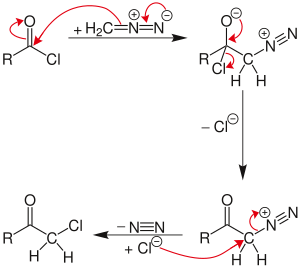Nierenstein reaction
| Nierenstein reaction | |
|---|---|
| Named after | Maximilian Nierenstein |
| Reaction type | Carbon-carbon bond forming reaction |
The Nierenstein reaction is an
from the diazomethane is inserted into the carbon-chlorine bond of the acid chloride.
Reaction mechanism
The reaction proceeds through a

If excess diazomethane is present during the reaction, it can act as a base, abstracting a hydrogen from the diazonium-salt intermediate. The result is a neutral diazoketone, which does not react with the chloride. Instead, the byproduct, diazonium-methyl from the other diazomethane molecule, can be attacked by the chloride to produce chloromethane. The unreactive diazoketone can be re-activated and reacted by treatment with hydrogen chloride to give the normal Nierenstein product.

In some cases, even limiting the amount of diazomethane gives a reaction process that stalls via the neutral diazoketone pathway, requiring the addition of HCl gas to rescue it.[3]
Scope
One original 1924 Nierenstein reaction:[4]

and a reaction starting from

See also
- Maximilian Nierenstein
- Curtius rearrangement
- Wolff rearrangement
- Arndt–Eistert reaction: where acid chlorides react with diazomethane to give chain extended carboxylic acids via a rearrangement
References
- .
- ^ Bachman, W. E.; Struve, W. S. (1942). "The Arndt-Eistert Reaction". Org. React. 1: 38. (Review)
- ^ McPhee, W. D; Klingsberg, E. Organic Syntheses, Coll. Vol. 3, p.119 (1955); Vol. 26, p.13 (1946). (Article)
- .
- .
